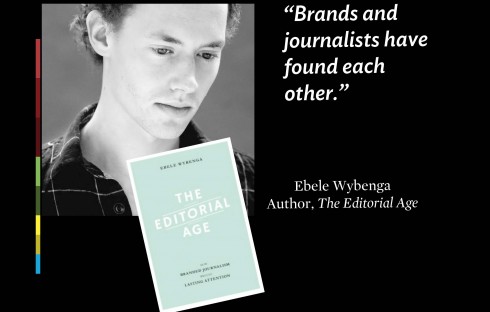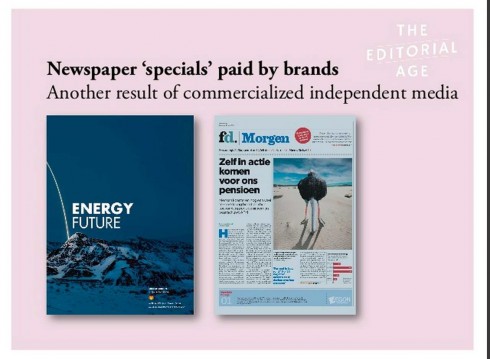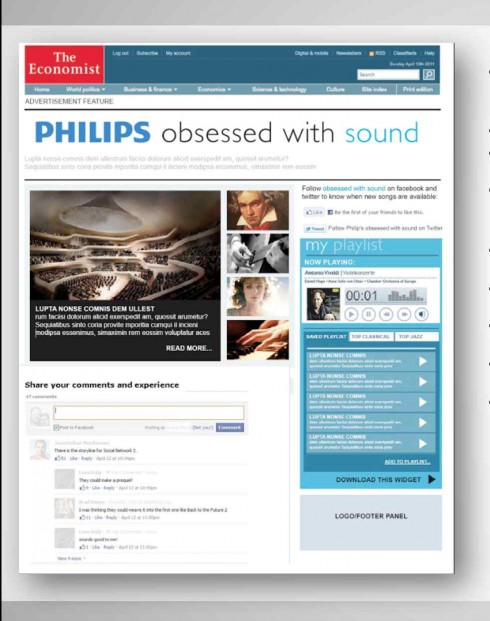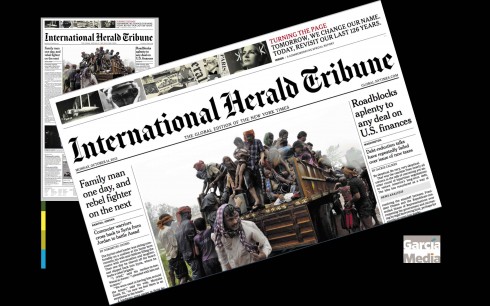TAKEAWAY: What happens when journalists need revenue while advertisers clamor for attention? Sponsored branded messages are the result. Ebele Wybenga, the young Dutch author of The Editorial Age, calls it “branded journalism”. We chat with Wybenga.

Advertisers want their brands positioned where they can be instantly noticed (and remembered), while journalists wand and need the revenue that comes from accommodating them. This is not necessarily a marriage made in media heaven, but one that has become a reality of our times.
It was at the recent WAN IFRA World Publishing Expo 2013 in Berlin, that I met Ebele Wybenga, the 26-year-old author of a book on the subject, The Editorial Age, whose mission is to convince us that “while journalism seems to have become more shallow, brands are looking for more substance.”
In a session titled Branded content: is it journalism?, Wybenga argued that the two areas of journalism and advertising can benefit from each other. His main point and the promise of his book: to reclaim the scarce and scattered attention of the public.
“It’s too many messages out there competing for the attention of the audience, so branded content that appears in niche publications become very attractive to advertisers,” Wybenga said. “Not to mention that journalists have never needed the revenue that comes from such transactions more than today.”
But Wybenga admits that this will not be easy to execute:
Many journalists are afraid that succumbing to commercial interests will irreparably damage the role of the press as public watchdog.
He tries to convince those journalists differently:
I argue that journalists can benefit from collaborations with brands and that brands can benefit from a journalistic approach, while serving, rather than misleading today’s audience.
In the age of mobile: more sponsored advertising


A sample from The Editorial Art: how brands can pay newspapers to include their messages as part of “specials”. In this example, ‘Energy Future’, on the left, is a Shell special added to NRC Handelsblad. ‘FD.Morgen’ on the right is a special by insurance company AEGON added to Het Financieele Dagblad.
What Wybenga is describing is a process that I believe is only in its infancy.
As more publishing houses develop extensions of their brand via mobile devices, such as smartphones and tablets, and as we begin to see more curated editions in these platforms, we will see a need for sponsorship ads.
I can imagine that a company like Starbucks, for example, may wish to be linked to a timely morning edition of a newspaper or magazine’s morning mobile edition, while restaurants and/or entertainment brands may seize similar opportunities for evening editions.
There is a natural synergy in these that is worth exploring. However, the advertising agencies themselves are not moving rapidly enough to facilitate the process. So, I recommend my clients that they take the initiative and go after selected potential advertisers once they have developed the product to accommodate specific ads.
Wybenga is right when he explains that “brands and journalists have found each other,” but that first they have to address some serious incompatibilities of character.
Sponsored content and native advertising are the end station of the blurring of commerce and content. Because this is becoming a mainstream movement in modern media, best practices are being developed helping traditional publishers survive trying times without turning away their audience.
What type of journalists are needed?

I asked Wybenga how he viewed a profile of the perfect journalist for today’s media environment, one where, among other things, the profession of the journalist and that of the advertising/marketeer must meet and collaborate.
Here is what he responded:
A new type of journalist and storyteller fit for this age would need at least a combination of these qualities and skills:
an instinct for getting people excited online, in other words: an understanding of ‘viral potential’
a love of ‘old fashioned’ long-form reporting
and preferably:
an understanding of the business side of news media (journalists have a stubborn tendency to look down on anything commercial)
the sensibilities of an advertising creative, including insight in the way brands influence our lives
Finally, journalists need to be conscious that they are building a ‘personal brand’. They have a reputation to care for and a following to gather. They will lose both if they don’t uphold journalistic principles.
This makes sense, and not just because it fits into the realities of a multi platform media world, but because knowledge we have had since the 1980s concerning the fact that our audience considers advertising as information, too. This, of course, at at time when advertising messages appeared on their side of the fence, never mixing with editorial content.
While members of the audience listening to Ebele Wybenga at the WAN IFRA conference may not have agreed with his views, I feel that his message resonated with a majority who, like me, feel that sponsored branded messages can be a good thing. It all depends on how the two sides of advertising and editorial protect their boundaries.
One reality is for sure: we have only begun to see this marriage of the world of brands and the world of the press. Stay tuned for much more.
Meanwhile, at The Economist

In one of the sessions at the WAN IFRA conference, Audra Martin, vice president for advertising/operations for The Economist, emphasized the importance of teaming up with advertisers to develop content synergies beyond traditional advertising, a strategy that has paid off well for her team at The Economist.
She showed how The Economist has partnered up with Philips as well as GE to showcase specific products under The Economist’s brand.
See our previous blog post about advertising:
https://www.garciamedia.com/blog/articles/pinteractive_sponsorship_ads_the_new_marriage_of_digital_advertising_editor
More about The Editorial Age
Wybenga explains that it is not easy YET to get his book, The Editorial Age, outside of the Netherlands. You can get the e-book in the Dutch and German iBookstore but not in the American one.
http://www.theeditorialage.com
https://itunes.apple.com/be/book/the-editorial-age/id678277135?mt=11
See slideshow of Wybenga presentation
Last International Herald Tribune today

Front page of the last edition of the International Herald Tribune. Starting Tuesday, Oct. 15, the newspaper will be called The International New York Times
Today Monday is the last day you will see this global newspaper still called International Herald Tribune. Starting Tuesday, it will be The International New York Times.
It is most likely part of the New York Times’ project to become a more globally recognized brand. I imagine that Jeff Bezos is probably watching with interest, since he is likely to do something similar with The Washington Post, which many believe, and I agree, has the same universal brand recognition to extend its brand globally. By the way, The New York Times and The Washington Post were co-publishers of the IHT until 2003 when it became only The Times.
A piece in The New York Times anticipates that some readers are not going to be happy with the name change:
Of course, a lot of people will lament the latest name change, just as they do any change. Among the letters to the editor I read in the papers of yore, one railed against ‘‘the loud-speaker radio’’ and the ‘‘croaking and screeching of unseen tenors and sopranos’’ filling Parisian apartment houses; another ranted against central heating — ‘‘What can beat a good coal fire for comfort and health?’’ And newspapers, I have learned, are notoriously habit-forming — loyal readers resist any alteration of their daily fix.
While the change of name may affect some, I wonder if the folks at the Times have worried about other side effects of the name change.
Recently, a Pakistani publisher told me that the name The International New York Times will not sit well with many in his country who now read the International Herald Tribune but don’t associate it with America, which they will do more readily when the New York Times appears in the logo. “This will be the same in many countries where there are high levels of anti Americanism,” he said.
Of related interest:
International Herald Tribune: Turning the Page
http://www.nytimes.com/interactive/2013/10/14/business/media/turning-the-page.html